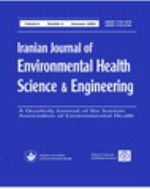
|
Iranian Journal of Environmental Health, Science and Engineering
Iranian Association of Environmental Health (IAEH)
ISSN: 1735-1979
Vol. 4, No. 2, 2007, pp. 107-112
|
 Bioline Code: se07016
Bioline Code: se07016
Full paper language: English
Document type: Research Article
Document available free of charge
|
|
|
Iranian Journal of Environmental Health, Science and Engineering, Vol. 4, No. 2, 2007, pp. 107-112
| en |
DEGRADATION OF AROMATIC COMPOUNDS USING MOVING BED BIOFILM REACTORS
Ayati, B.; Ganjidoust, H. & Mir Fattah, M.
Abstract
For biological treatment of water, there are many different biofilm systems in use. Examples of them are
trickling filters, rotating biological contactors, fixed media submerged biofilters, granular media biofilters
and fluidized bed reactors. They all have their advantages and disadvantages. Hence, the Moving Bed
Biofilm Reactor process was developed in Norway in the late 1980s and early 1990s to adopt the best
features of the activated sludge process as well as those of the biofilter processes, without including the
worst. Two cylindrical moving bed biofilm reactors were used in this study working in upflow stream
conditions. Experiments have been done in aerobic batch flow regime. Laboratory experiments were
conducted at room temperature (23–28°C) and synthetic wastewater comprising a composition of phenol
and hydroquinone in each reactor as the main organic constituents, plus balanced nutrients and alkalinity
were used to feed the reactor. The ratio of influent to effluent COD was determined at different retention
times. The results indicated that the removal efficiency of each selected compound is affected by the
detention time. At low phenol and hydroquinone concentration (from 700 to 1000 mg/L) maximum
removal efficiency (over 80%) was obtained. By further increasing in COD loading rate up to 3000 mg/L,
a decrease in COD removal rate was occurred. In the reactor containing pyrogallol in COD of 1500 mg/L,
the removal rate decreased to 10 percent because of its toxicity for microorganisms.
Keywords
Hydroquinone, Moving Bed Biofilm reactor, phenol, pyrogallol.
|
| |
© Copyright 2007 - Tehran University of Medical Sciences Publications
Alternative site location: http://diglib.tums.ac.ir/pub/
|
|
